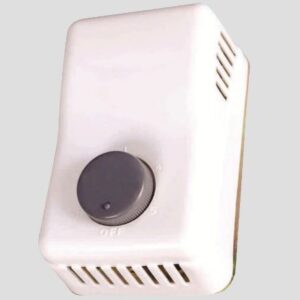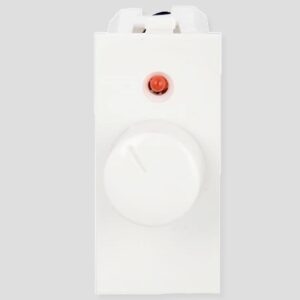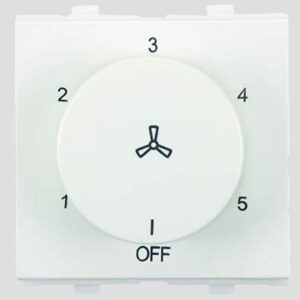Let’s explain different kinds of Speed Regulators for Ceiling Fans and the pros and cons of all. The objective is for consumers to know the importance of buying a good regulator as these days the companies do not supply regulators along with fans (except Remote Regulators). Often a cheap or incorrect outdated model of regulator can generate unpleasant humming noise and cause harm to the fan motor, which of course is not the fault of fan but of your buying decision.
Resistance/Choke Type Regulators
Till about 25/30 years back, all the Fan Companies used to sell fan with a compatible Regulator, which was often Resistance type (bulky in size). These were Power Guzzlers. These regulators had spools of wire with different amounts of resistances. When you set the knob at a particular position, you included a certain resistance in series with the fan. The resistance in circuit consumed its power. So, fan consumed same energy even at lower speeds and the regulators generated lot of heat.
There were also Choke Type regulators available during that period, which were better than Resistance but not the best solution.
These are both now virtually extinct.
Triac Based –Step less Regulators
These Step less regulators were the initial changeover from Resistance type or Choke type Bulky regulators and were primarily meant for dimming lights as well. These are still available and you may be tempted to buy because of low price.
These are better than the Resistance based regulator as it saves energy but they distort the Sine wave of the power supply which creates the humming sound of the motor. Distorted power supply is also not good for long-term health of the motor.
Capacitor type Regulators
This design and technology are the most appropriate Wall Mounted Regulator presently.
These helps save energy at various lower speed steps of regulator and do not become heated.
These regulate the fan speed by regulating the waveform of power supply and there is no distortion of the sine wave of the supply voltage.
So, these are your best choice but remember not to buy a less known brand or a local brand of such regulators which may be compromising on lower quality of components or trespassing certain circuits. It is better to spend another hundred rupees and buy a reputed brand to avoid any issues in the package.
Remember one point –Even with the best of Capacitor Regulator, your fan may not give uniform speed difference between each step as the motor designs of different brands and models is different. But these good regulators will not give any unpleasant humming sound or cause damage to motor.
So, let’s choose our wall mounted regulator wisely for the better performance of the Fan.
Remote Regulators
The latest flavor of the customers is Remote Type Regulators. These are expensive and are provided by companies as standard in most of the BLDC fan models. Some other non-BLDC fan models in upper end models and Fans with light too have these as standard and in same fan package.
For more details —Read this ———
Among the consumer friendly electronics and appliances, the usage of remote control is increasing day by day. Typically in an urban household, minimum 5 to 7 remote handsets are found in use for different appliances. Is it making us lazy or increasing our convenience? Perhaps, parts of both are true.
So, should their use be discouraged? That’s a point of discussion for another day. Today let’s focus on the technologies largely used in this.
Most commonly used technologies are IR, which stands for “Infrared” and RF, known as “Radio frequency”, IR is a kind of light that can’t be seen with the naked eye but can be seen through a digital camera or a phone camera and RF uses radio waves.
IR REMOTE – An IR remote control (transmitter) sends out pulses of infrared light that represent specific binary codes. These binary codes correspond to commands, such as Power On/Off, Speed Up – Down, etc. The IR receiver in other device decodes the pulses of light into the binary data (ones and zeroes) that the device’s microcontroller can understand. The microcontroller then carries out the corresponding command. It’s simple for you.
It is most commonly used as it is quick and offers an ability to communicate a wide variety of commands. Its downside is that you always need line-of-sight for it to work properly and it can work for shorter distances, may be within a room.
RF REMOTE – RF remote, on the other hand, do not require line-of-sight for working and also it can work over much longer distances. RF can pass through solid walls too – as long as they’re not metal.
RF (radio frequency) technology uses radio waves to transmit the signal from Remote to devices. Standard use of RF remote is Bluetooth, ZigBee (RF4CE) and Z-Wave.
PROS & CONS
IR REMOTE
• It can be used for short distance, up to 10 meters, suitable for use inside a room only.
• It needs “Line of Sight” towards the device of better operation, so it can be used in single direction.
Chances of missing command can happen if line-of-sight is not maintained.
• IR remote do not need pairing with devices. A single remote can be used to operate many devices by maintaining proper line-of-sight and distance from device.
• There is no statutory regulation for usage of IR remote as its signal do not affects other electrical / electronic devices.
• IR remote and its control in device is relatively less costly.
RF REMOTE
• It can be used for longer distances, up to 50 meters or more.
• No Line of Sight Required. It can be used in multi direction. A device can be operated even when remote is in other direction of device.
• A single RF remote needs pairing with its devices. After pairing you can control many devices with single remote. For individual control of devices, you need to do separate pairing and remote-control set.
• There are statutory regulations for usage of RF technology. For use of RF in Indian market, we need WPC certificate from Ministry of Communication and Information technology, Delhi.
• RF remote and its control in device are costlier.
For you as a Customer, both will work for any Fan equally. It is the manufacturer who decides which marries best with their model. What we are providing you is an in-depth understanding of 2 remote control technologies.
The bladeless fan is a fairly new concept that’s gaining popularity in the West. It’s a revolutionary innovation that has taken over the home cooling space by storm. And that is evident from the fact that, every year, an increasing number of homeowners are now switching from conventional fans to bladeless fans.
But despite these fans being so popular in the West, we are yet to go bladeless in India. And that brings us to the question – When is India going to ‘Go Bladeless’?
Though we don’t have an exact answer to that question, we will put across a few facts related to bladeless fans that will compel you to think if your next ceiling fan should be a bladeless one. Let us begin by finding out how a bladeless fan works.
How Bladeless Fans Work
Unlike conventional fans that blow air down, bladeless fans suck air from below and push it outwards, towards the walls, through the slits on the periphery of the fan (as you can see in the above image). This is considered a more efficient way of cooling as it pushes the air to all corners of the room and helps maintain unified temperature. Also, it is claimed that the bladeless fans generate a far more powerful airflow than the conventional fans, as bladeless fans work on the air-multiplying technology that is used in jet engines and turbochargers for generating high airflows.
The question for experts is if this is correct for a tropical country like India , where high quantum of air delivery is required in ceiling fans.
So does it Make Sense to ‘Go Bladeless’?
Well, there are more than a few benefits that bladeless fans offer. Let us go through them one by one.
The first and foremost benefit of bladeless fans is that they provide an even airflow. This is very critical in homes with air conditioning because uniform air distribution helps achieve the desired temperature, faster and this in turn helps save on energy bills. It also helps prevent hot air being trapped in the ceiling and cold air trapped on the floor.
Bladeless fans are ideal for rooms with low ceilings. Usually, people opt for wall fans or pedestal fans for rooms with low ceilings as there’s always a fear of people getting injured by a traditional fan. But bladeless fans being safer, there’s no fear of injury.
The next benefit of going bladeless is that they are noiseless. Unlike conventional fans that produce noise because of the movement of fan blades cutting through the air, bladeless fans don’t make any noise, at all. In fact, you would be surprised to know that conventional fans, even in the best of their shape, make some noise.
Maintenance of fans is another important factor when choosing a fan. The good thing about bladeless ceiling fans is that they do not accumulate dirt and dust as easily as the conventional fans. Also, they are easier to clean.
Bladeless fans are available in several styles and designs. They also come with unique features such as integrated dimmable LED lights to balance the room temperature. These features, however, are present in the new age conventional fans also, and so we will leave it for you to decide.
So, What’s Your Take?Now that you have some idea about bladeless fans let us know whether or not you would like to see bladeless fans being introduced in India. Let us know your take along with your reasons. We would love to read them.
During the late 80’s, interior decoration studios in Taiwan used to feature a very unique idea of curtain coordinated ceiling fan. The designer was pasting customer-provided curtain cloth to cover wooden blades creating a tapestry for coordinated look of a ceiling fan.
This influenced many interior designers worldwide to experiment. It can be seen at small studios in Connecticut in USA too.
The ceiling fans of Indian variety have curved aluminum blades. So it is a bit more difficult than flat wooden blades. Also, Indian fans have bottom motor covers which are required to be coordinated for a complete design look. The bottom cover is curved but placing tapestry element here is quite doable.
Have a look at one such Indian fan with tapestry of curtain laminated—and see how it looks in the room.
This was first experimented in the early 90’s with a downstream unit in Calcutta. The design studio had a downstream unit for customers looking for such decoration. The design process began by taking one meter of cloth and the cloth was pasted and laminated. Although, it was not hugely successful due to quality of lamination technology at that time, but it was hugely appreciated by the users.
Challenges faced during the decoration procedureThe units faced many challenges while pasting .The edges got crumpled after some time. It resulted in not sustainable lamination which with time turned opaque with dust. In the present times, technologically advanced pasting and lamination systems have been invented and all such issues should not be there.
Does this concept interest anyone—May be this is for a niche market yet totally worth exploring.
The cost and scopes of customizationThe estimated cost of applying tapestry of curtains on an Indian fan could be Rs. 300/- excluding the price of the cloth. It is pretty economical, as far as current rates of the home decorations are concerned.
The additional benefit is whenever you change your curtains or tapestry; the downstream unit will be ready to give a coordinated look on the fan blades and disc at a very reasonable price.
Any Takers? Any thoughts?
.
Recent Post
Categories
Tags
Bladeless Ceiling Fans BLDC Fans BLDC Motor Ceiling Fans Ceiling Fan Ceiling Fans Dual Blades in Portable Fans Energy Saving Fans Fan Blades Fan Inverters Fan Regulator Fans Fans are Covid-19 warriors Guide to Buying Ceiling Fan History of Electric Fans History Of Fan IFMA IFMA Editorial Indian Fan Industry Induction Motors Ceiling Fan LED Ceiling Fans Low Noise Ceiling Fans Pankahs Pankha Museum Pedestal Fans Portable Fans Remote Control Fan Remote Control of Fans Star Rated Ceiling Fans Unique Blade











